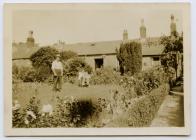William John Roberts (1906 – 1982), Bethesda
Items in this story:
My father, William John Roberts, ("William John, Pant", to his peers) was born at the family home, "Meillionen”", 10 Ffordd Pant, Bethesda, Gwynedd, on 4 March 1906. He died at the Caernarfonshire and Anglesey Hospital, Bangor, on 16 May 1982. His mother was Margaret ( nee Williams) and his father, from the point of view of all official documentation, was William R. Roberts. This brings us to the heart of an issue that is part of our family's heritage – namely, that William John was firmly convinced that his natural father was not William R Roberts, but rather Dr. Edward Mills Roberts. Dr. Edward Mills Roberts was a doctor at the Bryn Llwyd Hospital, a private hospital for Penrhyn Quarry workers. Margaret worked as a maid at the Hospital, and there is a picture of her and several others associated with the Hospital, including Mrs Mills Roberts ( but not Dr Edward Mills Roberts ) in Robin Willis's book, “The Penrhyn Quarry Hospital at Brynllwyd”. We may well never know what the truth was. But this is certainly what explains the semi-consistent use of quotation marks around the word "Father" in these two volumes. It is also clear that William John was not overly fond of his official father, and was hurt by William R. Roberts' lack of support and recognition.
They were quite a large family for their small home, with four brothers and two sisters born between 1903 and 1921. One of the sisters died at a very young age. Like almost every other man in Dyffryn Ogwen, at that time, William R Roberts worked at Penrhyn Quarry. It was also there that William John went in 1920, because – as he explains – the family could not afford to keep all the children in school. William John followed the regime that had been put together by that time for training and developing roof slate splitting and trimming skills, and also the skills associated with work at the rock face. It is important that we remind ourselves that this was achieved by following what he calls the "New Order" in the quarry. The "Old Order", a regime that would have been associated with the past, and with it the period of the Penrhyn Quarry Strike, between 1900 and 1903, had ended by 1920, and entirely new operational arrangements had been adopted. William John was no doubt amongst the earliest intake of young boys to experience the "New Order", and he discusses this period in detail. It is also equally important to remember that the Quarry remained a huge employer at that time, with 2000-2500 remaining employed.
The memories and stories he presents here take us in detail up to about 1930. By then, William John was an experienced, confident young quarryman, proud of his craft, who also clearly had a vivid interest in the history, geology and operation of the quarry. I think he was appointed to the post of slate "marker" around 1930. That would mean that he was a member of the management team, and therefore given a further opportunity to understand the arrangements and regimes of the quarry. He remained at the Quarry until 1939, and then joined the RAF.
Returned safely at the conclusion of World War II, in 1945, he resumed his work as a "marker". By this time, he had met and married my mother, Mary (Mair) Margaret Jones – she was a Bethesda girl, and a history teacher. They lived for a time in the flat above the Quarry Hospital, with my brother, Gareth, becoming part of the family in 1947. By 1954, William John had decided he did not wish to stay at the Quarry any longer. There are family tales (but no confirmation that I know of) that he was interviewed for a position as Penrhyn Quarry Manager, around this time, but did not succeed. I also believe he was interviewed for a position as Manager of Manod Slate Quarry, Blaenau Ffestiniog, around the same period. Unfortunately, there is little about the period between 1930 and 1954 in the records.
Regardless of that, he had testimonials relating to his engineering and electrical skill, from his time in the Air Force. Using these, he obtained a post at the Royal Aircraft Establishment in Boscombe Down in 1954. Mair and Gareth joined him a few months later. The family moved to Aber-porth, Ceredigion, in 1955, with William John gaining employment at the RAE research institute there. I was born in Cardigan in 1956, and the family then lived in Tremain, Parc-llyn and Aber-porth, until 1970.
Despite the family’s various moves, the Penrhyn Quarry, and the slate industry, were never far from William John's attention. A number of former quarrymen worked at the RAE, and the fraternal bonds between them survived the move to Ceredigion. It was also a great pleasure for him to welcome the Rev Huw Gwynfa Roberts, a native of Dyffryn Peris , as minister of the Hen Gapel, Aber-porth, in the mid-1960's. Frequent trips and holidays in the Ogwen Valley ( Nain, Mary's mother, lived in Tregarth) would give William John the opportunity to reignite his passion for the Quarry, and its people. But he had something else, more cruel, to remind him of his time at the Quarry. His health deteriorated in the late 1960's, he was diagnosed with silicosis, and also suffered from tuberculosis, a disease often associated with silicosis. He was treated at Gallt y Mynydd Hospital, near Llanybydder, for several months. After returning home to Aber-porth, William John and Mair decided that retiring to Dyffryn Ogwen, would be the next step for them, and they bought a home in Tregarth.
We moved there in the summer of 1970, and all of the writings included here are from the following six years. William John and Mair were happy to be back home in familiar surroundings, re-establishing links with childhood friends, and being part of their community. An opportunity, therefore, for Mair to join the extra-mural evening classes of her former Professor of History at Bangor University, A.H. Dodd ; and for William John to begin to record his recollections of the Quarry. The advent of the local community newspaper, Llais Ogwan, meant that William John (and many other, too) had the opportunity to publish their memories and share them with an appreciative audience. That appreciation was augmented by Mair’s skills as a historian - and later by myself, as well, as I was at Aberystwyth University from 1974 onwards, studying for a History degree.
Mair's death in October 1976 was a blow to all of us, and especially to William John. Some of the passion and desire to record and explain disappeared. In addition, too, the silicosis was increasingly influencing his ability to breathe and move, and life became much more challenging. He had to move to live in a care home in his final years, finding some comfort in writing and reminiscing. By this time, I had become a research student in the Department of Welsh History in Aberystwyth – and I soon realised that William John was an excellent source of first-hand knowledge relating to the social, political, cultural and religious history of Dyffryn Ogwen. Some of his information would be included in my PhD thesis.
William John died in 1982. His death certificate, as can be seen, states that his “death was due to an Industrial Disease”, namely silicosis. I had promised him, and myself, that I would in due course publishing his writings, so that a wider audience might benefit from the knowledge and experience of a proud, intelligent quarryman, who understood the relationship between community and slate quarry.
by
Dafydd Roberts




